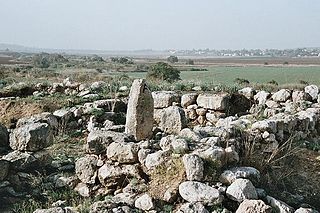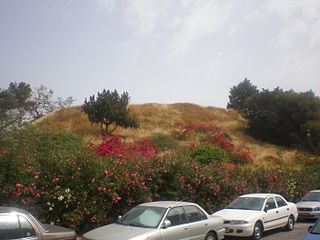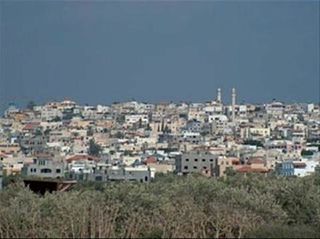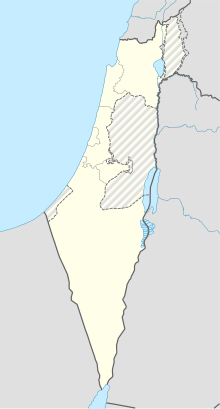
Antipatris was a city built during the first century BC by Herod the Great, who named it in honour of his father, Antipater. The site, now a national park in central Israel, was inhabited from the Chalcolithic Period to the late Roman Period. The remains of Antipatris are known today as Tel Afek, although formerly as Kŭlat Râs el 'Ain. It has been identified as either the tower of Aphek mentioned by Josephus, or the biblical Aphek, best known from the story of the Battle of Aphek. During the Crusader Period the site was known as Surdi fontes, "Silent springs". The Ottoman fortress known as Binar Bashi or Ras al-Ayn was built there in the 16th century.

Beit She'an, also Beth-shean, formerly Beisan, is a town in the Northern District of Israel. The town lies at the Beit She'an Valley about 120 m below sea level.

Kiryat Ata is a city in the Haifa District of Israel. In 2022 it had a population of 61,142, 92% of whom were Jewish citizens.

Amihai "Ami" Mazar is an Israeli archaeologist. Born in Haifa, Israel, he has been since 1994 a professor at the Institute of Archaeology of the Hebrew University of Jerusalem, holding the Eleazer Sukenik Chair in the Archaeology of Israel.

Tel Rehov or Tell es-Sarem, is an archaeological site in the Bet She'an Valley, a segment of the Jordan Valley, Israel, approximately 5 kilometres (3 mi) south of Beit She'an and 3 kilometres (2 mi) west of the Jordan River. It was occupied in the Bronze Age and Iron Age.

Benjamin Mazar was a pioneering Israeli historian, recognized as the "dean" of biblical archaeologists. He shared the national passion for the archaeology of Israel that also attracts considerable international interest due to the region's biblical links. He is known for his excavations at the most significant biblical site in Israel: south and south west of the Temple Mount in Jerusalem. In 1932 he conducted the first archaeological excavation under Jewish auspices in Israel at Beit She'arim and in 1948 was the first archaeologist to receive a permit granted by the new State of Israel. Mazar was trained as an Assyriologist and was an expert on biblical history, authoring more than 100 publications on the subject. He developed the field of historical geography of Israel. For decades he served as the chairman of the Israel Exploration Society and of the Archaeological Council of Israel. Between 1951 and 1977, Mazar served as Professor of Biblical History and Archaeology at the Hebrew University of Jerusalem. In 1952 he became Rector of the university and later its president for eight years commencing in 1953.

Timnath or Timnah was a Philistine city in Canaan that is mentioned in the Hebrew Bible in Judges 14 and in connection with Samson. Modern archaeologists identify the ancient site with a tell lying on a flat, alluvial plain, located in the Sorek Valley ca. 7 kilometres (4.3 mi) north-west of Beit Shemesh, near moshav Tal Shahar in Israel, known in Hebrew as Tel Batash or Teluliot Batashi (plural), and in Arabic as Tell Butashi or Teleilat Batashi (plural). The site is not to be confused with either the as yet unidentified Timna from the hill country of Judah, nor with the southern copper-smelting site of Timna in the Arabah near Eilat.

Gath or Gat was one of the five cities of the Philistine pentapolis during the Iron Age. It was located in northeastern Philistia, close to the border with Judah. Gath is often mentioned in the Hebrew Bible and its existence is confirmed by Egyptian inscriptions. Already of significance during the Bronze Age, the city is believed to be mentioned in the El-Amarna letters as Gimti/Gintu, ruled by the two Shuwardata and 'Abdi-Ashtarti. Another Gath, known as Ginti-kirmil also appears in the Amarna letters.

Farwana, was a Palestinian village, located 4.5 kilometers (2.8 mi) south of Bisan, depopulated in 1948.

Sandala is an Arab village in the Northern District of Israel. Near Afula, it falls under the jurisdiction of Gilboa Regional Council. In 2022 its population was 1,710.

Tel Gerisa or Tell Jerishe and Tell Jarisha (Arabic), commonly known as Tel Napoleon, as his army camped on it during the siege of Jaffa, is an archaeological site in Tel Aviv, Israel, on the southern bank of the Yarkon River. The Tel meaures c. 40 dunams. The main phases of the site are dated to the Middle and Late Bronze Ages, with a smaller settlement in Iron Age I and going into decline in Iron Age II.

Tel Shimron is an archaeological site and nature reserve in the Jezreel Valley.

Tell Beit Mirsim is an archaeological site in Israel, on the border between the lowlands of Shfela and Mount Hebron. It is located in the eastern region of Lachish about 20 kilometers southwest of Hebron and about 13 kilometers southeast of Lachish.

Jatt is an Arab local council in the Triangle area of Haifa District in Israel. In 2022 it had a population of 12,645.

Tel Zeton (Hebrew: תל זיתון, also known as Tell Abu Zeitun, is an archaeological site in the Pardes Katz neighborhood of Bnei Brak, Israel. It lies 800 m south of the Yarkon River. The mound rises to a height of 9 m above its surroundings and spans an area of 2–3 dunams. The site was inhabited in the Middle Bronze Age and later in the Iron and Persian periods. Jacob Kaplan identified the fortified settlement from the Persian period as a Jewish settlement from the time of the Return to Zion in the 5th century BCE, thanks to an ostracon bearing a Hebrew name which appears in the Hebrew Bible from the time of Nehemiah, a Jewish governor appointed by the Achaemenid Empire to govern the autonomous Jewish province. The site was inhabited as late as the 10th century CE, during the Roman, Byzantine, Early Arab, and Mamluk periods.
Tel Hashash or Tell el-Hashash is an archaeological site in the heart of the Bavli neighborhood of Tel Aviv. It is one of the ancient sites along the Yarkon River, located 800 meters south of the river, overlooking Tell Qasile on the northern bank of the river. The site was excavated in the 1960s by Jacob Kaplan on behalf of the Old Jaffa Museum of Antiquities, and in the 1980s by Haya Ritter Kaplan of the Israel Antiquities Authority. The excavations exposed remains of the first century CE and the late Byzantine period.

'En Esur, also En Esur or Ein Asawir, is an ancient site located on the northern Sharon Plain, at the entrance of the Wadi Ara pass leading from the Coastal Plain further inland. The site includes an archaeological mound (tell), called Tel Esur or Tell el-Asawir, another unnamed mound, and two springs, one of which gives the site its name.
Abattoir Hill, pronounced in Hebrew as Giv'at Bet Hamitbahayim, is an archaeological site in Tel Aviv, Israel, located near the southern bank of the Yarkon River. The site is a natural hill made of Kurkar, a local type of sandstone. In 1930 ancient burials and tools were discovered upon the construction of an abattoir on top of the hill, hence its name. Between 1950 and 1953, Israeli archaeologist Jacob Kaplan studied the site, ahead of the construction of new residential units and streets on it. He discovered the remains of burials and small settlements spanning from the Chalcolithic period to the Persian period. In 1965 and 1970 Kaplan conducted two more excavations next to the slaughterhouse and discovered settlement remains from the Bronze Age and the Persian period. In February 1992 a salvage excavation was conducted by Yossi Levy after antiquities were damaged by development works. Two burial tombs dated between the Persian period and the Early Arab period were discovered. In June 1998 another salvage excavation was conducted by Kamil Sari after ancient remains were damaged by work of the Electric Corporation. Two kilns were unearthed, similar to two found by Kaplan.

The Tel Qasile ostraca are two small ostraca found at Tell Qasile, then part of Mandatory Palestine, in 1945–46. The longer of the two ostraca is known as the Beth-horon sherd, on the basis of a possible reference to the biblical site of Bethoron. The Beth-horon sherd is now at the Israel Museum in Jerusalem.





















